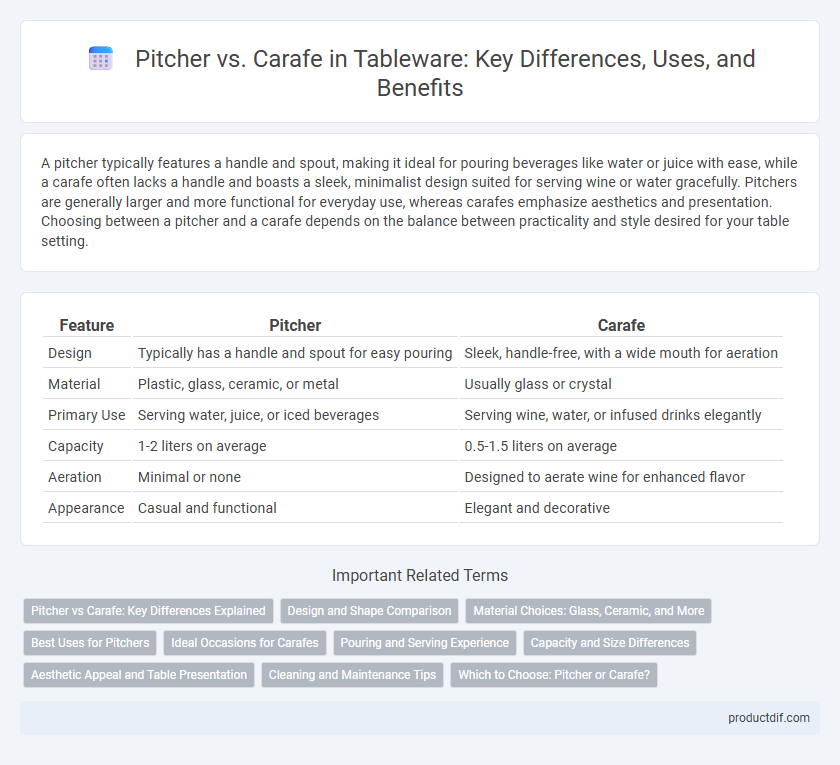A pitcher typically features a handle and spout, making it ideal for pouring beverages like water or juice with ease, while a carafe often lacks a handle and boasts a sleek, minimalist design suited for serving wine or water gracefully. Pitchers are generally larger and more functional for everyday use, whereas carafes emphasize aesthetics and presentation. Choosing between a pitcher and a carafe depends on the balance between practicality and style desired for your table setting.
Table of Comparison
| Feature | Pitcher | Carafe |
|---|---|---|
| Design | Typically has a handle and spout for easy pouring | Sleek, handle-free, with a wide mouth for aeration |
| Material | Plastic, glass, ceramic, or metal | Usually glass or crystal |
| Primary Use | Serving water, juice, or iced beverages | Serving wine, water, or infused drinks elegantly |
| Capacity | 1-2 liters on average | 0.5-1.5 liters on average |
| Aeration | Minimal or none | Designed to aerate wine for enhanced flavor |
| Appearance | Casual and functional | Elegant and decorative |
Pitcher vs Carafe: Key Differences Explained
A pitcher typically features a handle and a spout, designed for convenient pouring and holding larger quantities of beverages such as water or juice. In contrast, a carafe often lacks a handle, emphasizing an elegant design ideal for serving wine or coffee at the table. Understanding the distinctions between pitcher and carafe ensures appropriate use for both casual and formal dining settings.
Design and Shape Comparison
Pitchers typically feature a sturdy handle and a wide spout designed for easy pouring and grip, making them ideal for serving larger quantities of beverages. Carafes often have a sleek, handle-free design with a narrow neck and wider base, emphasizing elegance and easy pouring without additional grip support. The shape of pitchers prioritizes functionality and volume, while carafes focus on aesthetic appeal and refined presentation.
Material Choices: Glass, Ceramic, and More
Pitchers and carafes are commonly crafted from materials such as glass, ceramic, stainless steel, and plastic, each offering distinct benefits in durability and aesthetics. Glass pitchers and carafes provide clear visibility of contents and are ideal for showcasing beverages, while ceramic options offer excellent insulation and a stylish, handcrafted appearance. Stainless steel models deliver lasting strength and temperature retention, making them suitable for both hot and cold drinks in various settings.
Best Uses for Pitchers
Pitchers are best used for serving larger quantities of beverages such as water, iced tea, and lemonade at gatherings or family meals due to their ergonomic handles and spouts designed for easy pouring. Their durable construction often supports both cold and warm liquids, making them versatile for everyday use in homes and restaurants. Pitchers excel in functionality when frequent refilling or transporting drinks from the kitchen to the table is required.
Ideal Occasions for Carafes
Carafes are ideal for serving water, wine, or juice at formal dinners, brunches, and casual gatherings due to their elegant design and easy pouring spout. Their slim and often decorative shape makes them perfect for presenting beverages on dining tables or buffet setups. Unlike pitchers, carafes maintain the aesthetic appeal while serving beverages in settings where style complements function.
Pouring and Serving Experience
A pitcher typically features a spout and handle designed for easy, controlled pouring, making it ideal for serving larger quantities of beverages with minimal spills. Carafes often have a wider mouth and elegant shape, which enhances the aesthetic presentation but may require more careful handling to avoid drips. When choosing between a pitcher and a carafe, consider the importance of precision in pouring versus visual appeal during the serving experience.
Capacity and Size Differences
Pitchers typically have larger capacities, ranging from 1 to 2 liters, making them ideal for serving multiple guests, while carafes usually hold between 0.5 to 1 liter, designed for more modest servings. The size of pitchers often includes a wider body and a handle for easy pouring, whereas carafes feature a slender, handle-free design that emphasizes elegance. These capacity and size differences influence their practical use, with pitchers suited for casual, larger servings and carafes favored for formal dining or wine presentation.
Aesthetic Appeal and Table Presentation
Pitchers typically offer a robust and functional design ideal for casual settings, while carafes emphasize sleek, elegant shapes that enhance fine dining aesthetics. The clear glass construction of carafes allows the beverage's color and texture to become part of the table presentation, creating a visually appealing centerpiece. Pitchers often prioritize durability and volume capacity, making them practical yet less refined compared to the minimalist and artistic appeal of carafes.
Cleaning and Maintenance Tips
Pitchers typically have wider openings, making them easier to clean manually or in a dishwasher, while carafes often feature narrow necks that require specialized brushes for thorough cleaning. To maintain both types of tableware, rinse immediately after use to prevent stains and avoid harsh chemicals that can damage glass or ceramic finishes. Regularly check for lingering odors or residue in hard-to-reach areas to ensure optimal hygiene and longevity.
Which to Choose: Pitcher or Carafe?
Choosing between a pitcher and a carafe depends on your specific needs for serving beverages. Pitchers, often made of plastic or glass, typically have a handle and spout, making them ideal for pouring water, juice, or iced tea at casual gatherings. Carafes, usually crafted from glass or crystal without handles, offer a more elegant presentation suited for wine or coffee, enhancing the dining experience with their refined aesthetic.
Pitcher vs Carafe Infographic

 productdif.com
productdif.com